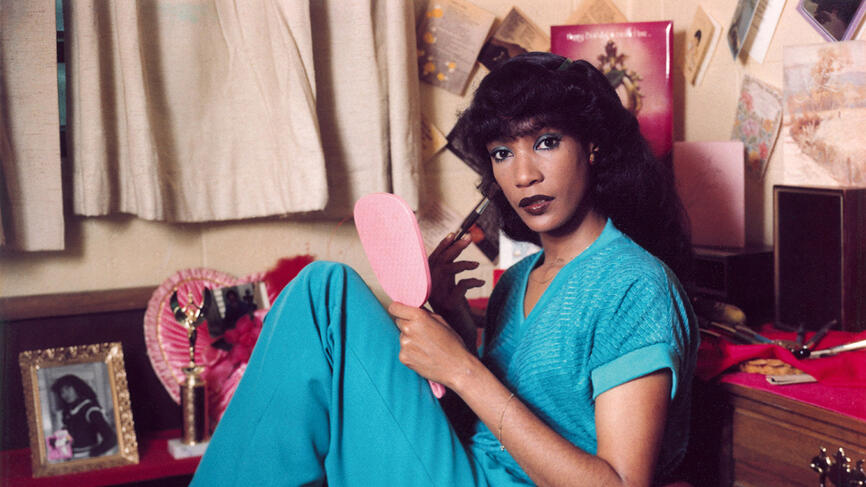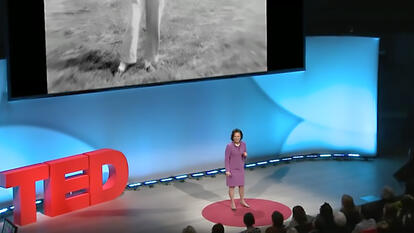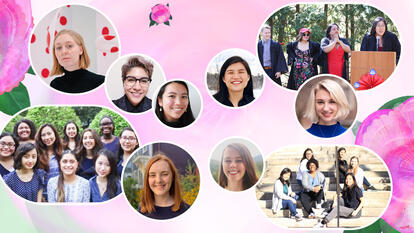
Turning the Lens on Mass Incarceration
Prison Nation, the photography show that opened this spring at Wellesley’s Davis Museum after an almost two-year pandemic delay, strives to heighten empathy and political awareness about incarceration in the United States. In a dark way, it seems fitting that the exhibit had to wait so long to be seen: The incarcerated people who are its subjects have been waiting years for freedom, and many will die in prison.
“How does your thinking about the United States change when you realize that we incarcerate more people than any other nation in the world?” asked Amanda Gilvin, the Sonja Novak Koerner ’51 Senior Curator and assistant director of curatorial affairs at the Davis, while giving a tour of the exhibit. More than 2 million people are currently incarcerated in the United States; the next highest is China with 1.69 million, followed by Brazil with 811,000, according to the World Prison Brief. Nearly one in every 100 people in the United States is behind bars. Prison Nation strives to heighten empathy and political awareness about incarceration in the United States, which is the first step in creating systemic change.
Prison Nation also examines the role photography itself has played in supporting incarceration. Incarcerated people are not allowed to have cameras, and photography has a long history of being weaponized to track and incriminate individuals. “How can you repurpose the same technology that the state used against you in the first place?” asked curator Nicole R. Fleetwood in a public conversation with Wellesley students, faculty, and members of the local community who work with incarcerated and formerly incarcerated people. Much of Prison Nation is about reclaiming photography, changing the focus, and reframing who is at the center.
Incarcerated people make up such a large portion of the population of the United States, but it is so rare to see art by or about incarcerated people. Never before have I had access to or experienced images like this.
Aiko Miller ’22
Fleetwood curated the exhibit with Michael Famighetti; it was organized by the New York nonprofit foundation Aperture and arranged for the Davis by Gilvin. Fleetwood, the author of Marking Time: Art in the Age of Mass Incarceration, has a personal connection to the criminal legal system—her cousin Allen was sentenced to life in prison when he was 18, and Fleetwood visited him regularly, often posing for family pictures taken by incarcerated people, in front of murals painted by incarcerated artists. Fleetwood’s personal collection of prison photographs is displayed alongside the work of 14 other artists in the show. While most of the artists have not been incarcerated themselves, the images are a stark reminder of how many people’s lives have been upended by mass incarceration. “It’s impossible to humanize people in prisons, because they’re already humanized—they’re human,” said Fleetwood in her conversation for the Davis. “We instead need to think about how prisons are actively trying to turn humans into non-humans.”
In addition to Fleetwood’s talk, Gilvin also curated conversations between artists, students, faculty, staff, and local community members who work with incarcerated people, which have been recorded and can be watched on the Davis’s YouTube page. Laura Grattan, Jane Bishop ’51 Associate Professor of Political Science, was invited by Gilvin to join the discussion with Fleetwood because of her role in the Project on Public Leadership and Action (PPLA), a faculty-led research and teaching initiative at Wellesley. “Incarceration is one of the most pressing and urgent crises of our day,” said Grattan. “It is an issue that is talked about and debated, but we do not see the people who are in jails and prisons. This exhibit is one entry point to begin to understand the people who are at the center of this everyday crisis.”
“What’s exciting about Prison Nation is that it marks our continuing effort as a community to draw attention to the effects of incarceration and criminalization and, to use a Nicole Fleetwood term, the ‘footprints’ of that in our community,” said Jennifer Musto, associate professor of women’s and gender studies, who co-directs PPLA with Grattan and has co-facilitated campus efforts to connect Wellesley students and faculty with community groups that work with currently and formerly incarcerated people. Musto sees this type of work as a way to support “co-learning” between people impacted by incarceration and members of the Wellesley community.

The exhibit “shines a light on a perspective we don’t often hear about,” said Ryan Rowe ’23, who worked as a student guide at the Davis for two and a half years. “These perspectives often go unseen, because photography and art cannot make it into these spaces.”
Rowe said Nigel Poor’s installation featuring photos made from old negatives found at San Quentin alongside an episode of Poor’s Ear Hustle podcast, which is recorded in the same prison, stayed with her the most because of the multisensory experience—hearing the voices of the incarcerated people in a space that, traditionally, does not usually showcase those voices.
“I’ve never seen an exhibit like Prison Nation before,” said Aiko Miller ’22, who is doing an independent study working with high-risk young women who have been impacted by incarceration. “Incarcerated people make up such a large portion of the population of the United States, but it is so rare to see art by or about incarcerated people. Never before have I had access to or experienced images like this.” As part of the Davis’s ongoing series of conversations with artists in the show, Miller interviewed Joseph Rodriguez and found his images of children impacted by incarceration particularly memorable.
Makayla Almonte ’24, president of Wellesley for the Abolition of Militarism and Incarceration (WAMI), was struck by the images of incarcerated women at MCI-Framingham, taken by Jack Lueders-Booth between 1978 and 1985. The women, who were his photography students, posed for portraits in street clothes, which let them regain some of their freedom of expression and individuality. “Incarceration like this shouldn’t be happening in the first place, and this exhibit makes it known and makes people aware that it is happening,” said Almonte. And happening so close to home too: MCI-Framingham is only 15 minutes from Wellesley, and 12 of the commonwealth’s 15 Department of Correction prisons are within an hour of campus.
Ana Luisa Brady McCullough ’22 interviewed Zora J Murff, a photographer who documents juvenile offenders, for the Davis. McCullough has worked with incarcerated women as a Ministrare Fellow: Pre-COVID, she volunteered in a pre-release program at South Middlesex Correctional Center (SMCC). “Deborah Luster’s portraits of the incarcerated actors really stayed with me,” said McCullough, of the large-scale, black-and-white portraits of people incarcerated at the state penitentiary in Angola, Louisiana, acting out a passion play. While the incarcerated women she worked with at SMCC had release dates on the horizon to look forward to, all but one of the subjects of Luster’s portraits will be imprisoned for the rest of their lives.
I want people to walk away from Prison Nation questioning what role we each play in the carceral state.
Laura Grattan, Jane Bishop ’51 Associate Professor of Political Science
McCullough is not the first Wellesley student to work with incarcerated people; Wellesley’s long history with local prisons was one of the reasons Gilvin wanted to bring the exhibit to the Davis. The College opened in 1875, and the Sherborn Reformatory for Women opened just over six miles away in 1877. “Both institutions were developed to shape women’s changing roles in society,” said Gilvin. At the time, Sherborn was seen as a progressive development—previously, women were incarcerated in men’s prisons—and Wellesley students often did charity work, such as making nosegays to bring to the women there. Often, Gilvin pointed out, the incarcerated women and girls were the same age as or younger than the college students.
Regina Gallardo ’23, who has worked at the Davis since her first year, emigrated from Mexico to the United States when she was 12; she lived near Miami in a town bordered by two prisons and an ICE detention center and said she had to learn about “the legacy of pain and suffering in this country” right away. Gallardo especially appreciated the objects Gilvin pulled from the Davis’s permanent collection to pair with the Prison Nation exhibit: Danny Lyon’s iconic photographs of incarcerated people in Texas from 1967 to 1969 and prints by Roger Shimomura that explore the United States’ internment of Japanese Americans. “Sure, you can leave the exhibit and wipe your hands of it, but then you go into the stairwell and there are more images,” said Gallardo. “You can’t ignore it.”
Betty Pfaelzer Rauch ’65, who helped fund Prison Nation, learned about the exhibit through Friends of Art at the Davis. Rauch has spent decades helping formerly incarcerated people through The Fortune Society, an organization that works with individuals who have been impacted by incarceration rebuild their lives, and she believes art can help teach critical thinking: “You can use art to ask some really hard questions,” said Rauch. The transfer prints made on bars of soap by Jesse Krimes, the only artist in the show who made their work while incarcerated, ask: Who is allowed to make art? Chandra McCormick and Keith Calhoun’s photos of incarcerated Black men doing unpaid labor on the sites of former plantations ask: Was slavery really abolished? The images of empty playgrounds in Sable Elyse Smith’s artist book, documenting the absence of her incarcerated father, ask: How many lives are affected by mass incarceration?

Musto said she appreciates how the exhibit challenges viewers to pose questions that can be difficult to grapple with only through books or texts. But Prison Nation is just the beginning: “How do we think beyond and in addition to the exhibition?” asked Musto. “How do we continue to create these spaces to have these conversations?”
“I want people to walk away from Prison Nation questioning what role we each play in the carceral state,” said Grattan. “Who we are, and what do we bring when viewing this kind of art? I also keep thinking about the stories of the people in these photos—the stories that are there, but also the stories that are not present.”
“Prison Nation makes moments of joy visible,” said McCullough, referring to Lucas Foglia’s enormous color photographs of detainees gardening as part of the Rikers Island GreenHouse program. “But it also forces us to look at the true horror of this system and the way it impacts people.” McCullough encourages those who are moved by the exhibit to get involved with helping incarcerated people or addressing reform of the criminal legal system, such as through The Petey Greene Program, Budget Buddies, and Black and Pink.
“We need as many people as possible to engage with and understand the impact of mass incarceration,” said Musto, praising Gilvin for how she brought together so many voices and perspectives in conversation for the exhibit. “If we don’t talk about the impact, then imagining otherwise becomes incredibly difficult.”
Prison Nation will be on display at the Davis, alongside several other new exhibits, until June 5, 2022. Click here to watch the artist interview with Nigel Poor and click here to watch A Conversation With Nicole R. Fleetwood.



